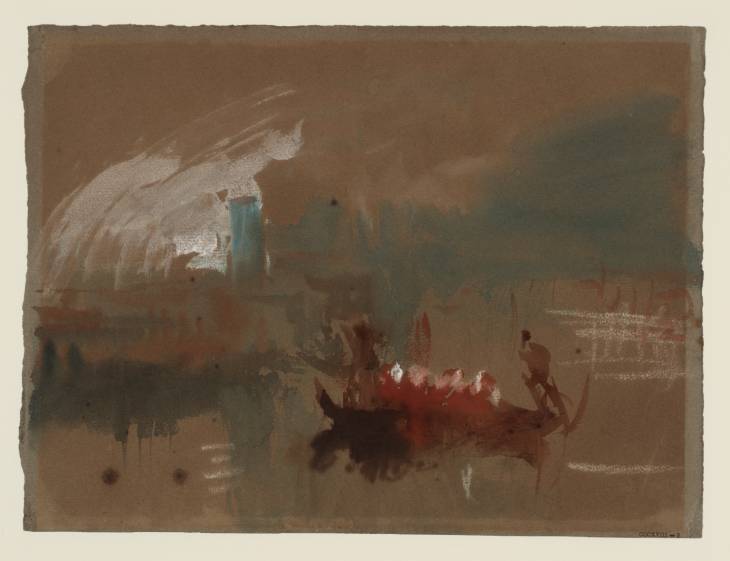Joseph Mallord William Turner Venice by Moonlight, with a Gondola 1840
Joseph Mallord William Turner,
Venice by Moonlight, with a Gondola
1840
Joseph Mallord William Turner 1775–1851
Venice by Moonlight, with a Gondola 1840
D32222
Turner Bequest CCCXVIII 3
Turner Bequest CCCXVIII 3
Watercolour and gouache on grey wove paper, 215 x 288 mm
Blind-stamped with Turner Bequest monogram towards bottom right
Stamped in black ‘CCCXVIII – 3’ bottom right
Blind-stamped with Turner Bequest monogram towards bottom right
Stamped in black ‘CCCXVIII – 3’ bottom right
Accepted by the nation as part of the Turner Bequest 1856
Exhibition history
1869
First Loan Collection selected from the Turner Bequest, various venues and dates 1869–before 1909 (no catalogue but numbered 103, as ‘Moonlight, Venice (Colour, on brown)’).
1922
Original Drawings in Watercolour, Etc., by J.M.W. Turner, R.A., T. Girtin and E. Dayes. Lent by the Trustees of the National Gallery, Laing Art Gallery and Museum, Newcastle 1922 (14, as ‘Moonlight, Venice’).
1972
Director’s Study, British Museum, London, September 1972 (no catalogue).
1983
Turner and the Human Figure: Watercolours from the Turner Bequest, Loaned by the British Museum, Tate Gallery, London, December 1983–July 1984 (no catalogue).
1992
Turner: The Fifth Decade: Watercolours 1830–1840, Tate Gallery, London, February–May 1992 (47, as ‘Venice: Moonlight’, c.1833–5, reproduced in colour).
1999
Turner’s Later Papers: A Study of the Manufacture, Selection and Use of his Drawing Papers 1820–1851, Tate Gallery, London, March–June 1999 (65, as ‘Venice: Moonlight, c.1833–5, reproduced).
References
1909
A.J. Finberg, A Complete Inventory of the Drawings of the Turner Bequest, London 1909, vol.II, p.1026, CCCXVIII 3, as ‘Moonlight; Venice. 1st Loan Collection, No.103’.
1922
Catalogue of Original Drawings in Watercolour, Etc., by J.M.W. Turner, R.A., T. Girtin and E. Dayes. Lent by the Trustees of the National Gallery, exhibition catalogue, Laing Art Gallery and Museum, Newcastle 1922, p.8 no.14, as ‘Moonlight, Venice’.
1930
A.J. Finberg, In Venice with Turner, London 1930, p.175, as ‘Moonlight scene’, probably 1835.
1833
Lindsay Stainton, Turner’s Venice, London 1985, p.45 no.10, as ‘Moonlight’, ?1833, pl.10 (colour).
1991
Ian Warrell, ‘R.N. Wornum and the First Three Loan Collections: A History of the Early Display of the Turner Bequest outside London’, Turner Studies, vol.11, no.1, Summer 1991, p.41 under no.103.
1833
Anne Lyles, Turner: The Fifth Decade: Watercolours 1830–1840, exhibition catalogue, Tate Gallery, London 1992, reproduced in colour p.35, 70 no.47, as ‘Venice: Moonlight’, c.1833–5, reproduced.
1995
Andrew Wilton, Venise: Aquarelles de Turner, Paris 1995, reproduced in colour pp.2 (detail), 93, as ‘Gondole et clair de Lune’.
1833
Peter Bower, Turner’s Later Papers: A Study of the Manufacture, Selection and Use of his Drawing Papers 1820–1851, exhibition catalogue, Tate Gallery, London 1999, pp.111–12 no.65, as ‘Venice: Moonlight, c.1833–5, pl.65A (colour detail), ‘Micrograph showing the difference in colour between the true grey of the sheet and the effect of light on the surface ... at x 15 magnification’.
2003
Ian Warrell in Warrell, David Laven, Jan Morris and others, Turner and Venice, exhibition catalogue, Tate Britain, London 2003, pp.259, 264 note 8.
The setting of this swiftly rendered but evocative moonlit scene, with much of the mid-toned paper left bare, is uncertain, assuming it is meant to represent a particular aspect of Venice from the Lagoon or closer in. The rudimentary blue silhouette of a distant campanile acts as a foil to the thick white gouache indicating the moon within a pale zone of the sky. The moonlight is complemented by a bright point of light in a lantern carried on the boat traversing the scene, a juxtaposition going right back to Turner’s first exhibited oil painting, Fishermen at Sea of 1796 (Tate T01585).1
The characteristic leaning action of the gondolier is caught in a few liquid strokes; see under Tate D32174 (Turner Bequest CCCXVI 37), a Grand Canal view, for other examples and discussion. Compare also the mood and arrangement of two colour studies on white paper in the contemporary Grand Canal and Giudecca sketchbook (D32125–D32126; CCCXV 9, 10).
Ian Warrell has noted the possible confusion between this sheet and other Venice subjects in relation to the early Loan Collections from the Turner Bequest and corresponding entries in Finberg’s 1909 Inventory. He has suggested that the supposed Turner Bequest CCCXVII 3, ‘The Ducal Palace’, listed there as no.98 in the second selection2 but noted as missing since the 1930s, may be a duplication of Tate D32247 (Turner Bequest CCCXVIII 28) or D32246 (CCCXVIII 27), called ‘Moonlight’ by Finberg and listed by him as no.103 in the First Loan Collection (earlier National Gallery listings quoted by Warrell giving it as ‘Moonlight, Venice (Colour, on brown)’);3 confusingly, Finberg also gave the same exhibition history to the present work, which he called ‘Moonlight; Venice’.4 In 1930, he , listed ‘cccxviii. 3’ as ‘Moonlight scene’.5
Technical notes:
There is a little dark spotting, particularly at the bottom left. The paper has acquired a darker, warmer appearance through light exposure during prolonged early display, affecting the tonal balance; paler grey strips are evident around the edges, which were protected by a mount.1
This is one of numerous 1840 Venice works Ian Warrell has noted as being on ‘Grey wove [paper], with a textured surface, produced by an unknown maker’ mostly measuring around 218 x 285 mm:2 Tate D32222, D32234–D32236, D32243–D32244 (Turner Bequest CCCXVIII 3, 15–17, 24, 25).
Verso:
Blank; inscribed by Turner in ink ‘28’ bottom right, upside down; inscribed in pencil ‘36’ centre, ascending vertically; stamped in black with Turner Bequest monogram over ‘CCCXVIII – 3’ bottom left; inscribed in pencil ‘CCCXVIII.3’ bottom centre. For Turner’s ink numbers on the backs of Venice subjects, see the Introduction to the tour.
Matthew Imms
September 2018
How to cite
Matthew Imms, ‘Venice by Moonlight, with a Gondola 1840 by Joseph Mallord William Turner’, catalogue entry, September 2018, in David Blayney Brown (ed.), J.M.W. Turner: Sketchbooks, Drawings and Watercolours, Tate Research Publication, December 2019, https://www

